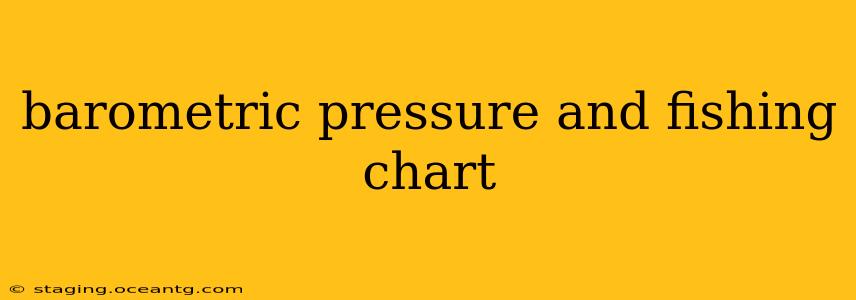For anglers, understanding the relationship between barometric pressure and fishing success is crucial. A barometric pressure chart can be an invaluable tool, helping you predict the best times to cast your line and potentially increase your catch. But how does it all work? This guide delves into the science behind it, explains how to interpret barometric pressure charts, and provides tips for maximizing your fishing success.
What is Barometric Pressure?
Barometric pressure, also known as atmospheric pressure, is the weight of the air pressing down on the Earth's surface. It's measured in millibars (mb) or inches of mercury (inHg). Changes in barometric pressure are largely influenced by weather systems. High-pressure systems typically bring fair weather, while low-pressure systems often precede storms.
How Does Barometric Pressure Affect Fish?
Fish, being sensitive creatures, react to changes in barometric pressure. These changes affect their behavior, feeding habits, and overall activity levels. Generally speaking:
-
Falling Barometric Pressure: Often precedes stormy weather. This can cause fish to become more active, feeding aggressively before the storm hits. This is because the lower pressure can reduce the amount of dissolved oxygen in the water, prompting them to feed more intensely.
-
Stable Barometric Pressure: Usually signifies fair weather conditions. During periods of stable pressure, fish generally exhibit normal feeding patterns. This is often a consistent period of good fishing.
-
Rising Barometric Pressure: Typically follows a storm and indicates improving weather. Fish tend to become less active during rising pressure, often seeking deeper waters or shelter. Their feeding activity usually decreases.
Interpreting Barometric Pressure Charts for Fishing
Barometric pressure charts track changes in pressure over time. These charts, often available online or through weather apps, are essential for predicting fishing conditions. Look for:
-
Trends: The direction of pressure change (rising, falling, or stable) is more important than the absolute pressure reading. A consistent fall often indicates better fishing opportunities.
-
Rate of Change: A rapid drop in pressure can sometimes lead to erratic fish behavior, while a slow, steady decrease is often more favorable.
-
Historical Data: Comparing current pressure readings with past data from the same location can provide valuable insights into how fish react to specific pressure changes in that particular area.
What is the Ideal Barometric Pressure for Fishing?
There's no single "ideal" barometric pressure for all fish species in all locations. The optimal pressure varies depending on the species, water temperature, and other environmental factors. However, many anglers find that falling or stable pressure generally offers better fishing conditions. Experimenting and keeping a fishing log noting your catches correlated with the barometric pressure will be invaluable in determining the optimal pressure for your specific fishing spot and target species.
How to Use a Barometric Pressure Chart for Fishing Success
-
Check the Forecast: Consult a weather forecast that includes barometric pressure readings.
-
Identify Trends: Observe the pressure trend (rising, falling, or stable) over the past few hours and predict the future trend.
-
Consider the Time of Year: Fish behavior varies seasonally, so consider the time of year when interpreting pressure data.
-
Choose Your Location: Select fishing spots based on the predicted pressure changes and the typical fish behavior in those areas during those conditions.
-
Adjust Your Techniques: Adapt your fishing techniques to match the predicted fish activity levels. For example, use more aggressive lures during falling pressure.
-
Keep a Log: Record your catches along with the corresponding barometric pressure readings to fine-tune your understanding of the pressure's influence on fishing success in your area.
Does Barometric Pressure Affect All Fish Equally?
No, different fish species react differently to barometric pressure changes. Some are more sensitive than others. Extensive field observation and data collection is necessary to understand how specific fish species behave under varying pressure conditions in different aquatic environments. This is where your personal fishing log comes in very handy.
What Other Factors Influence Fishing Success Besides Barometric Pressure?
While barometric pressure is a significant factor, it's not the only one. Other influential variables include:
-
Water Temperature: Fish are ectothermic, meaning their body temperature is regulated by their environment. Water temperature significantly impacts their metabolism and activity.
-
Time of Day: Fish often exhibit different feeding patterns throughout the day.
-
Moon Phase: Some anglers believe moon phases influence fish behavior, but scientific evidence is limited.
-
Currents and Tides: These can significantly affect fish distribution and feeding patterns.
By understanding the interplay between barometric pressure and these other factors, you can significantly improve your fishing success and plan your outings with greater confidence. Using a barometric pressure chart, along with careful observation and record-keeping, will turn you into a more successful angler.
